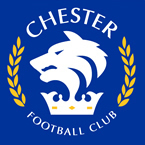|
CHESTER v WREXHAM RIVALRY
It was a classic case of the irresistible
force meeting the immovable object. Arfon Griffiths'
swashbuckling Wrexham side came up against a solid
Chester team that Alan Oakes had made difficult to
beat. Both teams fielded a strong contingent of locally
born players. By Monday 3rd April 1978 when they clashed
at the Racecourse, Chester knew they were out of the
running as far as promotion went. Wrexham were ahead
of the pack, had two impressive runs in the FA and
League Cups under their belt and were favourites to
win the Welsh Cup, having defeated Chester on the way.
A crowd of twenty thousand, many wearing pristine red
and white scarves, flocked to the ground in anticipation
of English lamb being served up. The size of attendance
was not unusual. Wrexham have been able to tap into
deep North Walian roots of support – but in the
lean times, transport to Merseyside and Manchester
is cheap and easy.
Before the match Arfon Griffiths
was presented with a copy of the club's new disc "We're
Gonna Score" recorded by Brymbo Male Voice Choir. But
it was the Chester fans who sang all the way home as
they pulled off a surprising 2-1 victory. The Robins
had been unbeaten in the League at home and had lost
only to Liverpool and Arsenal in the respective cups – now
Chester became the third member of an illustrious trio.
The stars of both clubs were in the
ascendant. Wrexham went on to win promotion and the
Welsh Cup and enjoy five seasons in the Second Division.
But the seeds of Chester's demise were already being
sown. Both clubs were in the throes of ground improvements.
Sealand Road was adorned with a new 3,000 seater stand
for the 1979-80 season. The cost, including savage
interest repayments, crippled the club. Not even the
sale of the young starlet Ian Rush (�300,000 with no
sell on clause) could stem the financial crisis. Playing
fortunes dipped as a result and after florist Reg Rowlands,
chairman for thirty-four years, stepped down, he was
followed by a succession of property speculators with
no local loyalty. Each in turn saw City's salvation
in terms of sale and relocation. The new stand of 1979
was reduced to rubble only thirteen years later.
The development of a new ground entailed
exile at Macclesfield for Chester and meant that City's
youth and reserve teams went by the board. This cost
the club dearly as neighbouring rivals, like Crewe,
expanded their youth catchment area to include Chester.
Danny Murphy was one of the many fish that got away
from Chester's net. As City finally developed a youth
policy, the club was plunged into instability again
because of an inability to sell players on. Then in
1999 a new owner, American Terry Smith, began to import
players from abroad. Chester's most capped player had
been Bill Lewis with seven appearances for Wales. Angus
Eve, a Trinidadian international, who joined Chester
last season, eclipsed this record.
Chester's saga of stadium development
is a long and fraught one. But so is Wrexham's – though
they have managed to stay put at the Racecourse. New
stands were built in the seventies in order to entice
the Welsh national side back to North Wales. Remember
it was here that England lost a home international
4-1 accompanied to cries of "Are you Chester in disguise!" But
as the Robins' playing fortunes waned so redevelopment
stalled. Some of the plans were breathtakingly ambitious – a �44
million development unveiled in 1991 remains on the
architect's drawing board.
That same year Wrexham finished bottom
of the pile and were only saved from the Conference
by League restructuring. Nine years later and Chester
are not so lucky. Even the influx of foreign stars – Eve
of Trinidad, Martin Nash of Canada, could not keep
City from the drop. The League has lost its only international
local derby. A mere twelve miles separate the two towns
but so does the border between England and Wales. The
intense local rivalry will continue among the fans
only now there is a chasm in terms of footballing status.
Colin
Mansley
|
